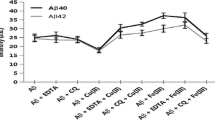Abstract
We present here a modulating effect on lysozyme derived Amyloid β fibrils by aqueous magnetic fluid. This non-conventional approach of treatment of lysozyme derived Amyloid β fibrils showed lysing of Amyloid fibrils to its secondary structures which can be seen using optical microscope and scanning electron microscopic image. The size of lysozyme derived amyloid fibrils before and after treatment was measured using dynamic light scattering technique. The mechanism of defragmentation of lysozyme derived Amyloid β fibrils by magnetic fluid is explained. This is a first report to identify the secondary structure of protein using Fourier Transform Infrared (FTIR) and Circular Dichroism (CD) spectra after lysing. The cyto-toxicity study of this magnetic fluid on neuronal (SH-SY5Y) and non-neuronal (NRK) cell lines shows non-toxicity up to a concentration of 250 μg/mL. The study indicates a novel and unique complementary approach to treat the amyloidogenic brain diseases.









Similar content being viewed by others
References
Liu Z, Jiao Y, Wang Y, Zhou C, Zhang Z. Polysaccharides-based nanoparticles as drug delivery systems. Adv Drug Deliv Rev. 2008;60:1650
Yohan D, Chithrani BD. Applications of nanoparticles in nanomedicine. J Biomed nanotech. 2014;10:2371
Kim BY, Rutka JT, Chan WC. Nanomedicine. New Engl J Med. 2010;363:2434
El-Desouki RAKM. New insights on Alzheimer’s disease. J. Microscopy and Ultrastructure. 2014;2:57
Kontush A, Berndt C, Weber W, Akopyan V, Arlt S, Schippling S. et al. Amyloid-β is anantioxidant for lipoproteins in cerebrospinal fluid and plasma. Free Radic Biol Med. 2001;30:119.1
Reiman EM. Alzheimer's disease: Attack on amyloid-β protein. Nature. 2016;537:36
Sadigh-Eteghad S, Talebi M, Farhoudi M, Golzari SEJ, Sabermarouf B, Mahmoudi J. β-Amyloidexhibits antagonistic effects on alpha 7 nicotinic acetylcholine receptors in orchestrated manner. J Med Hypotheses Ideas. 2014;8:49
Koneracká M, Antošová A, Závišová V, Lancz G, Gažová Z, Šipošová K. et al. Characterizationof Fe3O4 magnetic nanoparticles modified with dextran and investigation of their interaction with protein amyloid aggregates. Acta Phys Pol-Ser A General Phys. 2010;118:983
Skaat H, Belfort G, Margel S. Synthesis and characterization of fluorinated magnetic core–shell nanoparticles for inhibition of insulin amyloid fibril formation. Nanotechnology. 2009;20:225106
Bellova A, Bystrenova E, Koneracka M, Kopcansky P, Valle F, Tomasovicova N. et al. Effect of Fe3O4 magnetic nanoparticles on lysozyme amyloid aggregation. Nanotechnology. 2010;21:065103
Koneracká M, Antošová A, Závišová V, Gažová Z, Lancz G, Juríková A. et al. Preparation and characterization of albumin containing magnetic fluid as potential drug for amyloid diseases treatment. Phys Proceedia. 2010;9:254
Antosova A, Siposova K, Koneracka M, Zavisova V, Daxnerova Z, Vavra I. et al. Magnetic fluid—a novel approach to treat amyloid-related diseases. Phys Proceedia. 2010;9:262
Skaat H, Chen R, Grinberg I, Margel S. Engineered polymer nanoparticles containing hydrophobic dipeptide for inhibition of amyloid-β fibrillation. Biomacromolecules. 2012;13:2662
Cabaleiro-Lago C, Quinlan-Pluck F, Lynch I, Lindman S, Minogue AM, Thulin E. et al. Inhibition of amyloid beta protein fibrillation by polymeric nanoparticles. J Ame Chem Soc. 2008;130:15437
Cabaleiro-Lago C, Lynch I, Dawson KA, Linse S. Inhibition of IAPP and IAPP (20− 29) fibrillation by polymeric nanoparticles. Langmuir. 2009;26:3453
Shaw CP, Middleton DA, Volk M, Lévy R. Amyloid-derived peptide forms self-assembled monolayers on gold nanoparticle with a curvature-dependent β-sheet structure. ACS nano. 2012;6:1416
Cabaleiro-Lago C, Szczepankiewicz O, Linse S. The effect of nanoparticles on amyloid aggregation depends on the protein stability and intrinsic aggregation rate. Langmuir. 2012;28:1852
Wu WH, Sun X, Yu YP, Hu J, Zhao L, Liu Q. et al. TiO2 nanoparticles promote beta-amyloid fibrillation in vitro. Biochem Biophys Res Comm. 2008;373:315
Linse S, Cabaleiro-Lago C, Xue WF, Lynch I, Lindman S, Thulin E. et al. Proceedings of the National Academy of Sciences. Proc Natl Acad Sci.2007;104:8691
Parikh N, Parekh K. Technique to optimize magnetic response of Gelatin coated magnetic nanoparticles. J Mater Sci Mater Med. 2015;26:7–1
Nevskaya NA, Chirgadze YN. Infrared spectra and resonance interactions of amide-I and II vibration of alpha-helix. Biopolymers. 1976;15:637
Martin SR, Bayley PM.Calcium-Bind Protein Protoc: Methods Tech. Springer Publications, 2002;2:43
Greenfield NJ. Using circular dichroism spectra to estimate protein secondary structure. Nat Protoc. 2006;1:2876
Gopal R, Park JS, Seo CH, Park Y. Applications of circular dichroism for structural analysis of gelatin and antimicrobial peptides. Int J Mol Sci. 2012;13:3229
Gaihre B, Khil MS, Kim HY. In vitro anticancer activity of doxorubicin-loaded gelatin-coated magnetic iron oxide nanoparticles. J Microencapsul. 2011;28:286
Young S, Wong M, Tabata Y, Mikos AG. Gelatin as a delivery vehicle for the controlled release of bioactive molecules. J Control Release. 2005;109:256
Ziv O, Avtalion RR, Margel S. Immunogenicity of bioactive magnetic nanoparticles: Natural and acquired antibodies. J Biomed Mater Res Part A. 2008;85:1011
Bieschke J, Russ J, Friedrich RP, Ehrnhoefer DE, Wobst H, Neugebauer K. et al. EGCG remodels mature α-synuclein and amyloid-β fibrils and reduces cellular toxicity. Proc Natl Acad Sci. 2010;107:7710
Fei L, Perrett S. Effect of nanoparticles on protein folding and fibrillogenesis. Int J Mol Sci. 2009;10:646
Joachim E, Kim ID, Jin Y, Kim KK, Lee JK, Choi H. Gelatin nanoparticles enhance the neuroprotective effects of intranasally administered osteopontin in rat ischemic stroke model. Drug Deliv Transl Res. 2014;395:4.5–6
Rocha S, Thünemann AF, do Carmo Pereira M, Coelho M, Möhwald H, Brezesinski G. Influence of fluorinated and hydrogenated nanoparticles on the structure and fibrillogenesis of amyloid beta-peptide. Biophys Chem. 2008;137:35
Acknowledgements
Authors would like to thank DST, Govt. of India for providing financial support to NP under technology development project no. 161-G and CHARUSAT for providing experimental facilities.
Author information
Authors and Affiliations
Corresponding author
Ethics declarations
Conflict of interest
The authors declare that they have no conflict of interest.
Rights and permissions
About this article
Cite this article
Parikh, N.P., Parekh, K.H. Defragmentation of lysozyme derived Amyloid β fibril using Biocompatible Magnetic fluid. J Mater Sci: Mater Med 29, 171 (2018). https://doi.org/10.1007/s10856-018-6185-7
Received:
Accepted:
Published:
DOI: https://doi.org/10.1007/s10856-018-6185-7




